
From manufacturing and engineering precision parts to providing precise measurements for quality control by way of preservation, medical aids, and CGI, the best professional 3D scanners have revolutionized the implementation of 3D modeling into countless applications and industries.
Are you looking for a reliable, professional 3D scanner to complement your design workflow but not sure where to start? We’re to help with a comprehensive guide to the best options on the market.
If you need a crash course in what 3D scanners can do, we’ll also cover the underpinning technologies, popular applications, and the top features to look out for. Let’s dive in.
What are Professional 3D Scanners?
Professional 3D scanners are pro-grade devices capable of capturing the dimensions, measurements, and features of a real-world object, space, or human in seconds to construct an equivalent, digital 3D model.
Professional 3D Scanners differ from consumer-grade scanners. They are designed to offer:
- Higher levels of accuracy
- Better resolutions
- Faster scan speeds
This makes them suitable for a range of demanding industrial applications and work environments.
Applications
Professional 3D scanners are employed in a wide variety of applications, the number growing as the technology becomes more affordable and propagates throughout more and more industries.
The best professional 3D scanners are the tools of choice for prototyping, reverse engineering, architectural and automotive restoration, heritage conservation, quality control in manufacturing, custom orthotics and implants, dental modeling, crime scene documentation, virtual reality, and game development.
Types of Professional 3D Scanners
Though all professional 3D scanners perform the same essential function of collecting data from a real-world object to create a 3D model, the technology changes depending on the device. Here’s a brief explanation of the most common types.
Laser Triangulation – Laser triangulation 3D scanners sweep a laser across the surface of an object. The scanner then measures how the laser’s trajectory deforms and reflects in relation to sensors mounted on the scanner to map the object’s measurements and shape.
Structured Light – Like laser triangulation, structured light 3D scanners project a light pattern onto an object. The scanner then analyzes deformations and reflections on the light pattern’s edges to measure an object’s size and shape based on the distance to scanner-mounted sensors.
Handheld vs Stationary – Handheld professional 3D scanners allow for more flexibility and portability, usually prized for scanning hard-to-reach places and larger objects while being easy to operate. Stationary professional 3D scanners suit smaller objects, employing a tripod and turntable setup to automate the scanning process for applications where highly-accurate and feature-rich scans are a must.
Best Professional 3D Scanners
Shining 3D EinScan SP – affordable professional 3D scanner
- Price: $2,300
- Accuracy: 0.05 mm
- Resolution: 0.2 mm
- Max Scan Volume: 200×150 mm
- Technology: Structured light
- Speed/Frame Rate: 4 secs/scan
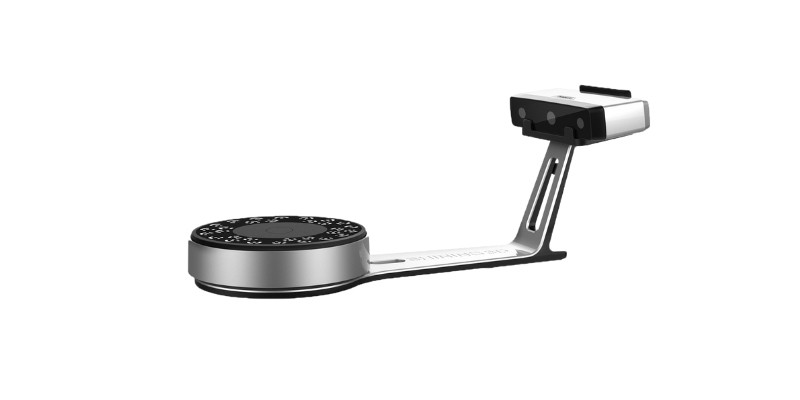
Pros
Good detail and precision.
Captures a single scan in four seconds and a full 360° scan in around a minute.
Compact footprint and solid post-processing software.
Cons
Scan volume is limited in auto-mode.
Affordability meets performance with yet another stellar offering from Shining 3D, one of the leading professional 3D scanner manufacturers. A stationary scanner, the EinScan SP offers 0.05 mm accuracy and 0.2 mm resolution, delivering a level of detail and precision you’d expect to pay much more for.
The EinScan SP captures a single scan in four seconds and a full 360° scan in around a minute. The Auto Scan mode takes care of all aspects of scanning, with effortless, one-click scanning of small to medium-sized objects.
A compact footprint and solid post-processing software are further benefits. We also like that the scanner can be mounted either onto the provided turntable or paired with a tripod, offering a helpful degree of flexibility.
Suitable applications include reverse engineering, product design, animation, CGI, virtual reality, and digital archiving.
Einscan H/HX/Pro
- Price: $5,000/$12,000/$8,500
- Accuracy: 0.05 mm/0.04 mm/0.045 mm
- Resolution: 0.25 mm
- Max Scan Volume: 420 x440 mm/310 x 240 mm
- Technology: Hybrid Structured light and infrared
- Speed/Frame Rate: 1,200,000points/s, 20FPS/3,000,000 points/s, 10 FPS
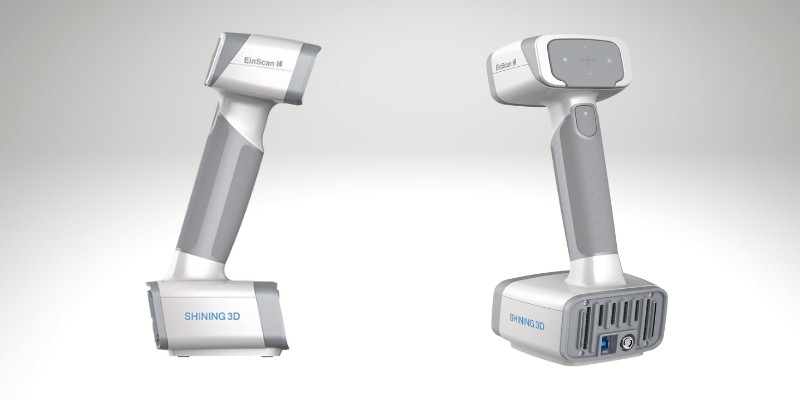
Pros
Captures usually trickier surfaces and outdoor objects.
Performs well when capturing fine details and features of objects.
Industrial-grade handheld.
Cons
Can be pretty expensive for the specs.
The EinScan H, HX, Pro professional 3D scanners distinguish themselves from the competition as two-birds-one-stone industrial-grade handheld solutions.
They employ a hybrid technology featuring LED structured light and infrared technology to perform scans. In practice, the scanners are equally adept at capturing usually trickier surfaces and outdoor objects via infrared as blazing through scans thanks to the structured light scanning.
Depending on the model, accuracy wavers between 0.5 mm and 0.4 mm, both strong starting points for demanding applications like reverse engineering, quality control, and straight design work.
Thanks to a 0.25 mm resolution, they also perform well when capturing fine details and features of objects ranging from human faces, pieces of art, and intricate mechanical parts.
Peel 3D Peel 2
- Price: $8,000
- Accuracy: 0.1 mm
- Resolution: 0.5 mm
- Max Scan Volume: 380 x 380 mm
- Technology: Structured light
- Speed/Frame Rate: 550,000 points/s
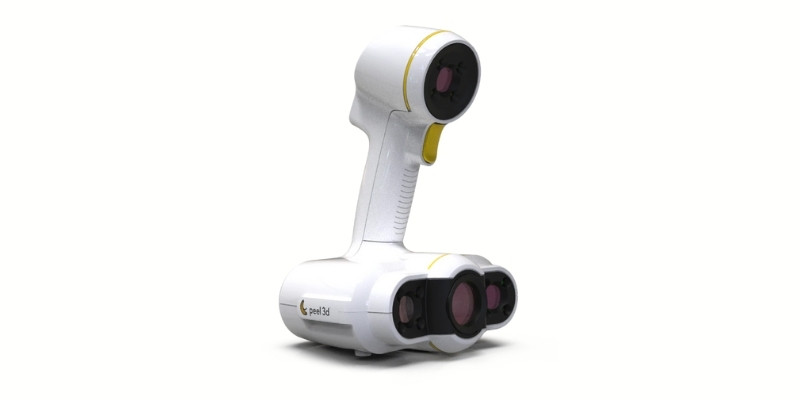
Pros
Excels in applications requiring accurate capture of medium to large objects.
Ideal for human body scanning.
Good for working with small objects and parts, thanks to optimized field of view and increased resolution.
Cons
Software may be difficult for beginners.
A point-and-shoot handheld professional 3D scanner from Canadian manufacturer Peel 3D, the Peel 2 excels in applications requiring accurate capture of medium to large objects, with a particular emphasis on the faithful replication of textures.
The scanner pushes a 0.1 mm accuracy and 0.5 mm resolution, ideal for human body scanning, 3D printing, design, reverse engineering, and automotive work. It doesn’t cost a fortune, either, and is touted as a complete solution with a refined workflow from scanning to software processing.
The Peel 3D Peel 2-S is also worth considering if you’re working with small objects and parts, thanks to an optimized field of view and increased 0.1 mm resolution capable of picking up finer details.
Polyga Compact S1
- Price: $6,000
- Accuracy: 0.35 mm
- Resolution: 0.07 mm
- Max Scan Volume: 115 x 100 mm
- Technology: Structured light
- Speed/Frame Rate: 2,000,000 points/s
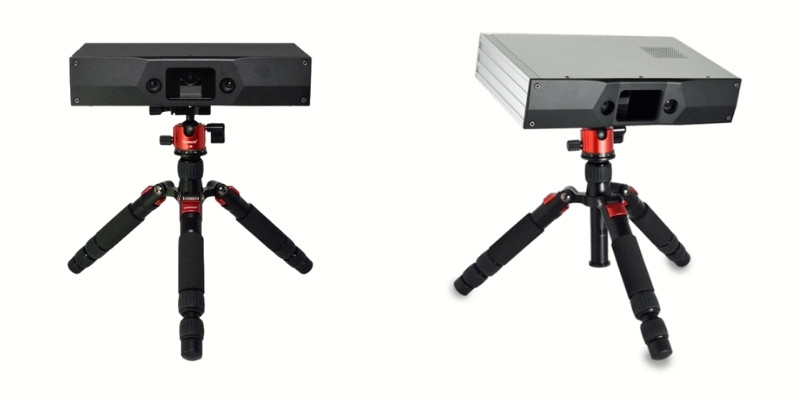
Pros
Affordable and good scan quality.
Produces a level of scan quality and fidelity that’s impressive for the price.
Simple setup and effortless scanning.
Cons
While good for the price, there are more powerful 3D scanners out there.
Marketed as an entry-level stationary professional 3D scanner occupying that sweet spot between affordability and scan quality, the Polyga Compact S1 is an excellent option for dentistry, quality control, and general 3D modeling.
Put to the test, the Polyga Compact S1 produces a level of scan fidelity and quality that’s impressive for the price. It also has a stand-out 0.07 mm resolution, a specification that’s generally the first to suffer to keep costs down, but not here. The plug-and-play design means a simple setup and effortless scanning within minutes.
Polyga’s Compact range doesn’t end with the S1. With four other models, each suited to different part sizes and applications, check these out if the S1 doesn’t quite align with your needs. The large-format L6, for example, is designed to scan large objects, such as the human body and hefty automotive parts, at high resolutions.
Creaform HandySCAN Silver 307
- Price: $18,000-$20,000
- Accuracy: 0.040 mm
- Resolution: 0.1 mm
- Max Scan Volume: 275 x 250 mm
- Technology: Laser Triangulation
- Speed/Frame Rate: 480,000 points/s
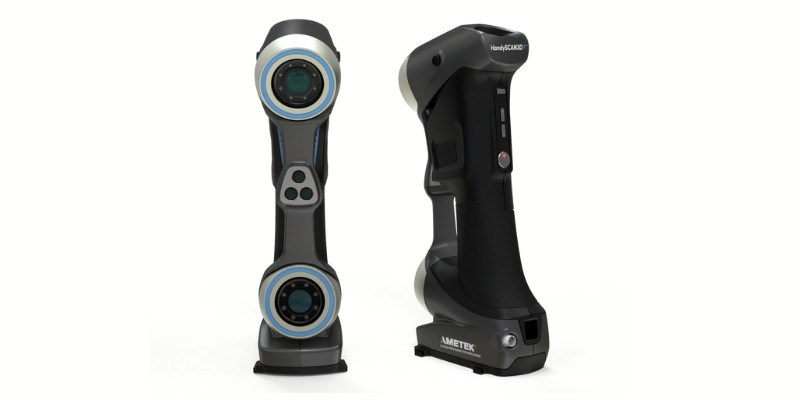
Pros
Reliably scans complex objects with various surface types.
Versatile and performs well regardless of the object size.
One of the most accessible and usable options.
Cons
Doesn’t come cheap.
Equipped with metrology-grade, patented technology, the Creaform HandySCAN Silver 307 is a handheld 3D scanner geared to tackle even the most demanding applications.
It relies on a 0.040 mm accuracy and 0.1 resolution to reliably scan complex objects with various surface types. A versatile professional scanner, the Creaform HandySCAN Silver 307 performs well regardless of the object size, something quite unusual in this market where manufacturers tend to focus on either small, detail-rich scan or larger ones.
With an $18,000-$20,000 price tag, the Creaform HandySCAN Silver 307 doesn’t come cheap. Still, it remains one of the most accessible and usable options, with sleek usability and an ergonomic design conducive to heavy usage. It’s an ideal tool for engineering fields, product development, and manufacturing applications.
Artec Eva
- Price: $16,000-$17,000
- Accuracy: 0.1 mm
- Resolution: 0.2 mm
- Max Scan Volume: 536 × 371 mm
- Technology: Structured light
- Speed/Frame Rate: 18,000,000 points/s, 16 FPS
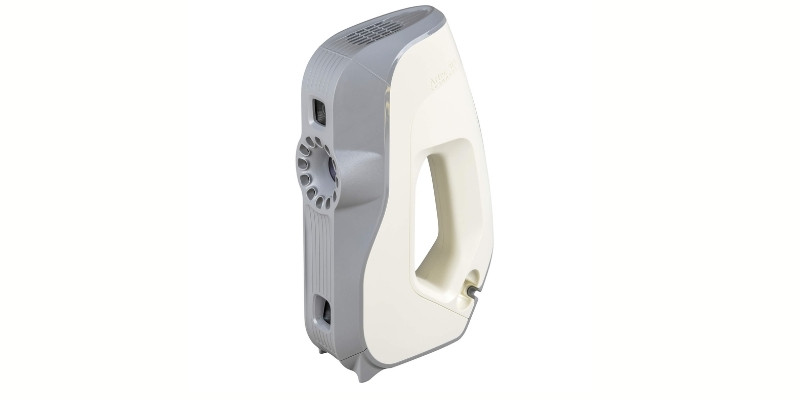
Pros
A powerful solution for applications focused on scanning medium-sized objects.
Quick and efficient.
Versatile in many applications.
Cons
Not great for small objects.
Within 3D scanner circles, Artec Eva’s reputation precedes it, best exemplified by its bestselling handheld Artec Eva professional 3D scanner, a powerful solution for applications focused on scanning medium-sized objects.
Quick and efficient, the Artec Eva delivers high-quality results thanks to a 0.1 mm accuracy and 0.2 mm resolution, throwing in full-color scanning and a lightweight design for easy, portable scanning.
Versatility is also a large part of what makes the Artec Eva such a popular pick. Applications include aerospace, orthopedics, industrial design, reverse engineering, archeology, CGI, prosthetics, plastic surgery, rapid prototyping, and custom aids.
Zeiss Gom Scan 1
- Price: $26,000-$27,000
- Accuracy: 0.1 mm
- Resolution: 0.037 mm
- Max Scan Volume: 400 x 250 mm
- Technology: Structured light
- Speed/Frame Rate: 6,000,000 points/s, 16 FPS
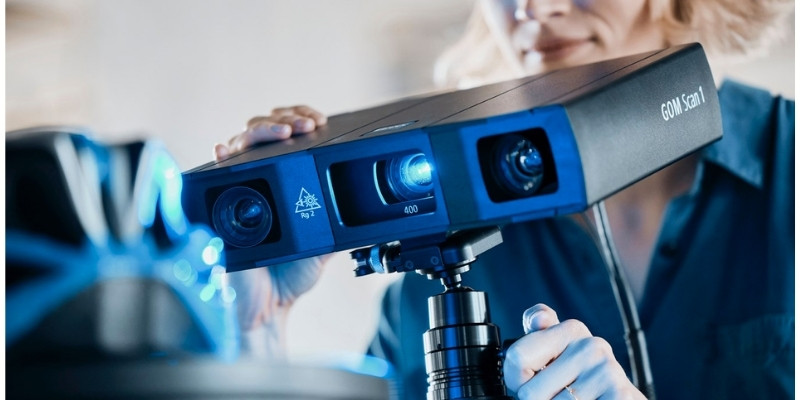
Pros
Adapts to different conditions by filtering out interfering ambient light for quality scans every time.
Compact shape and light weight.
One of the most competent 3D scanners on the market.
Cons
The field of view is fixed.
Through blue light technology, the Zeiss Gom Scan 1 adapts to different conditions by filtering out interfering ambient light for quality scans every time. Though technically a stationary professional 3D scanner, the Zeiss Gom Scan 1’s compact shape and low weight allow for scanning flexibility, even in tight areas or confined spaces.
Under the hood, the Zeiss Gom Scan 1 offers a resolution up to an impressive 0.037 mm, positioning it as one of the most competent 3D scanners on the market for complete surface detail scans. It fares best for smaller objects, something to keep in mind.
The powerful GOM Inspect Suite is also an impressive bonus, capable of refining 3D models and exporting them in all the most common formats.
eviXscan Optima+ M
- Price: $30,000
- Accuracy: 0.009 mm
- Max Scan Volume: 320 x 190 mm
- Technology: Structured light
- Speed/Frame Rate: 1.2 secs/scan
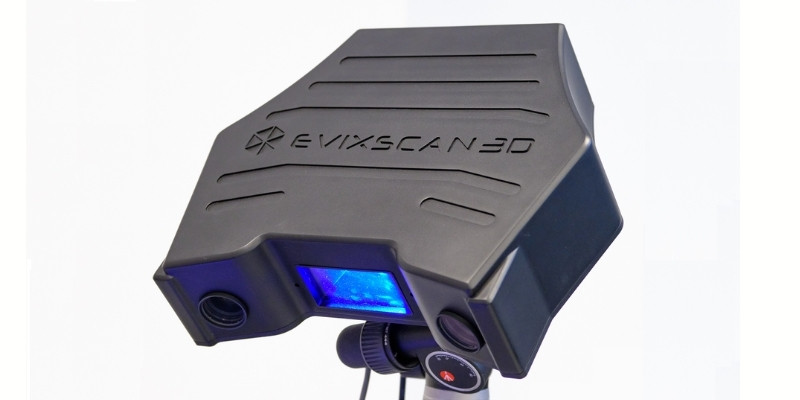
Pros
Ultra-fine resolution.
Its precision makes it a reliable tool for low tolerance reverse engineering.
Scan times are low at 1.2 seconds.
Cons
High price.
With an ultra-fine resolution of 0.009 mm, the eviXscan Optima+ M offers a level of detail few other professional 3D scanners can match. The eviXscan Optima+ M’s precision makes it a reliable tool for low tolerance reverse engineering, uncompromising non-contact quality control, and rapid prototyping for manufacturing, automotive, and general design.
Aside from this main appeal, the eviXscan Optima+ M uses a duo of high-speed 7 MP cameras and keeps scan time down to 1.2 seconds while maintaining excellent quality modeling. Lightweight and compact, the eviXscan Optima+ M is usable as a stationary scanner mounted on a tripod or paired with a robotic arm.
Best Professional 3D Scanners Buyer’s Guide – Things to Consider
Resolution and Accuracy
Resolution measures the detail and quality of a scan as measured by the gap between data points on a 3D model. For the most demanding applications, we recommend a resolution of 0.1 mm.
Accuracy is a little different in that it measures a professional scanner’s ability to replicate the precise measurements of a real-world object. For professional 3D scanners, 0.1 mm represents a bare minimum in our estimation, with the most advanced options offering accuracy as low as 0.009 mm.
Price
Thanks to a flurry of new options hitting the market in recent years, buying a reliable and accurate professional 3D scanner at a budget that aligns with your finances has never been easier. Depending on your needs, it’s entirely possible to pay under $2,000 for a good quality general use professional 3D scanner.
If you’re looking for the most advanced options boasting best-in-the-business accuracy, expect to pay north of $30,000.
Use Case
Finding the right 3D scanner can be quite tricky, but honing in on what you want to scan can slim down your shortlist. Consider the size of the scanned objects, your resolution/accuracy tolerances, and whether you need the convenience of a handheld professional 3D scanner or prefer the largely automated process of a stationary device.
Time For Your Project to Complete
When it comes to scanning speed, it’s worth considering whether you can take a slight downgrade in overall scan quality for a significant boost in scan speed. In other words, consider a scanner in relation to how quickly you need to complete a project. If time is on your side and you need high accuracy results, perhaps a slower but more precise option is better.
Best Professional 3D Scanners – FAQs
Other articles you may be interested in:




